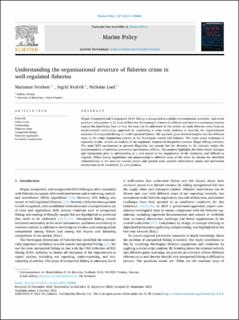| dc.contributor.author | Svorken, Marianne | |
| dc.contributor.author | Kvalvik, Ingrid | |
| dc.contributor.author | Lord, Nicholas | |
| dc.date.accessioned | 2023-10-09T07:08:29Z | |
| dc.date.available | 2023-10-09T07:08:29Z | |
| dc.date.created | 2023-10-05T09:50:17Z | |
| dc.date.issued | 2023 | |
| dc.identifier.citation | Marine Policy. 2023, 157 1-8. | |
| dc.identifier.issn | 0308-597X | |
| dc.identifier.uri | https://hdl.handle.net/11250/3095129 | |
| dc.description.abstract | Illegal, Unreported and Unregulated (IUU) fishing is recognised as a global environmental, economic, and social problem, taking place in all kinds of fisheries. Preventing it is however difficult and there is a continuous need to expand the knowledge base on how the issue can be addressed. In this article we study fisheries crime from an environmental criminology approach by conducting a crime script analyses to describe the organisational structure of unreported fishing in a well-regulated fishery. The approach gives detailed insights into the different steps in the crime commission process in the Norwegian coastal cod fisheries. The crime script technique is expanded to also include an analysis of the regulatory framework designed to prevent illegal fishing activities. The main MCS mechanisms to prevent illegalities are present but the diversity in the industry makes the implementation of universal prevention mechanisms difficult. The analysis highlights the fisher-buyer dialogue and interactions prior to misreporting as a core aspect to the organisation of the violations, and difficult to regulate. When linking regulations and guardianship to different steps of the crime we discuss the identified vulnerabilities in the resource control system and present some possible intervention points and prevention mechanisms to be considered by policymakers. | |
| dc.language.iso | eng | |
| dc.title | Understanding the organisational structure of fisheries crime in well-regulated fisheries | |
| dc.title.alternative | Understanding the organisational structure of fisheries crime in well-regulated fisheries | |
| dc.type | Peer reviewed | |
| dc.type | Journal article | |
| dc.description.version | publishedVersion | |
| dc.source.pagenumber | 1-8 | |
| dc.source.volume | 157 | |
| dc.source.journal | Marine Policy | |
| dc.identifier.doi | 10.1016/j.marpol.2023.105860 | |
| dc.identifier.cristin | 2181906 | |
| dc.relation.project | Nofima AS: 13321 | |
| dc.relation.project | Norges forskningsråd: 319473 | |
| cristin.ispublished | true | |
| cristin.fulltext | original | |
| cristin.qualitycode | 1 | |
